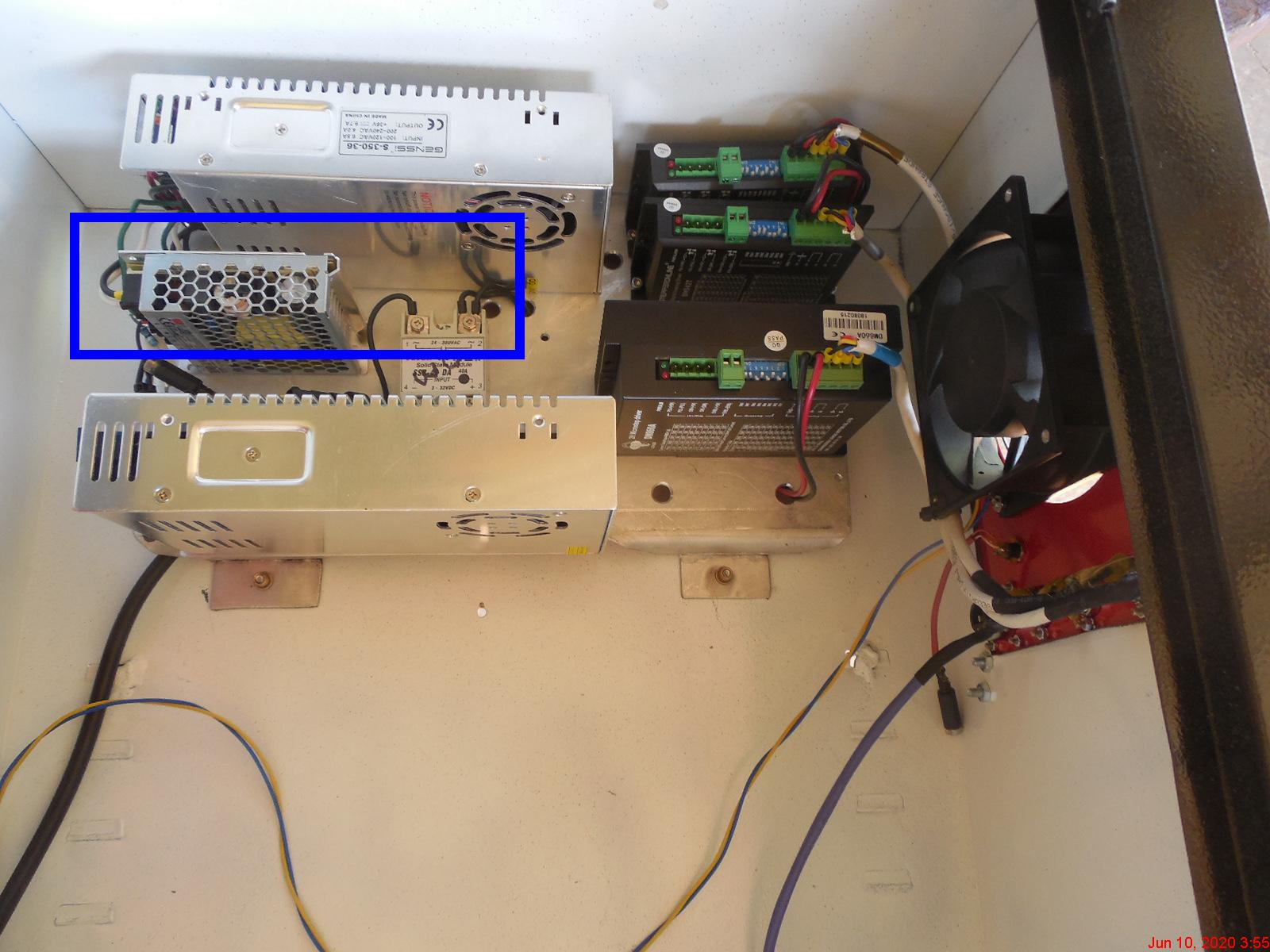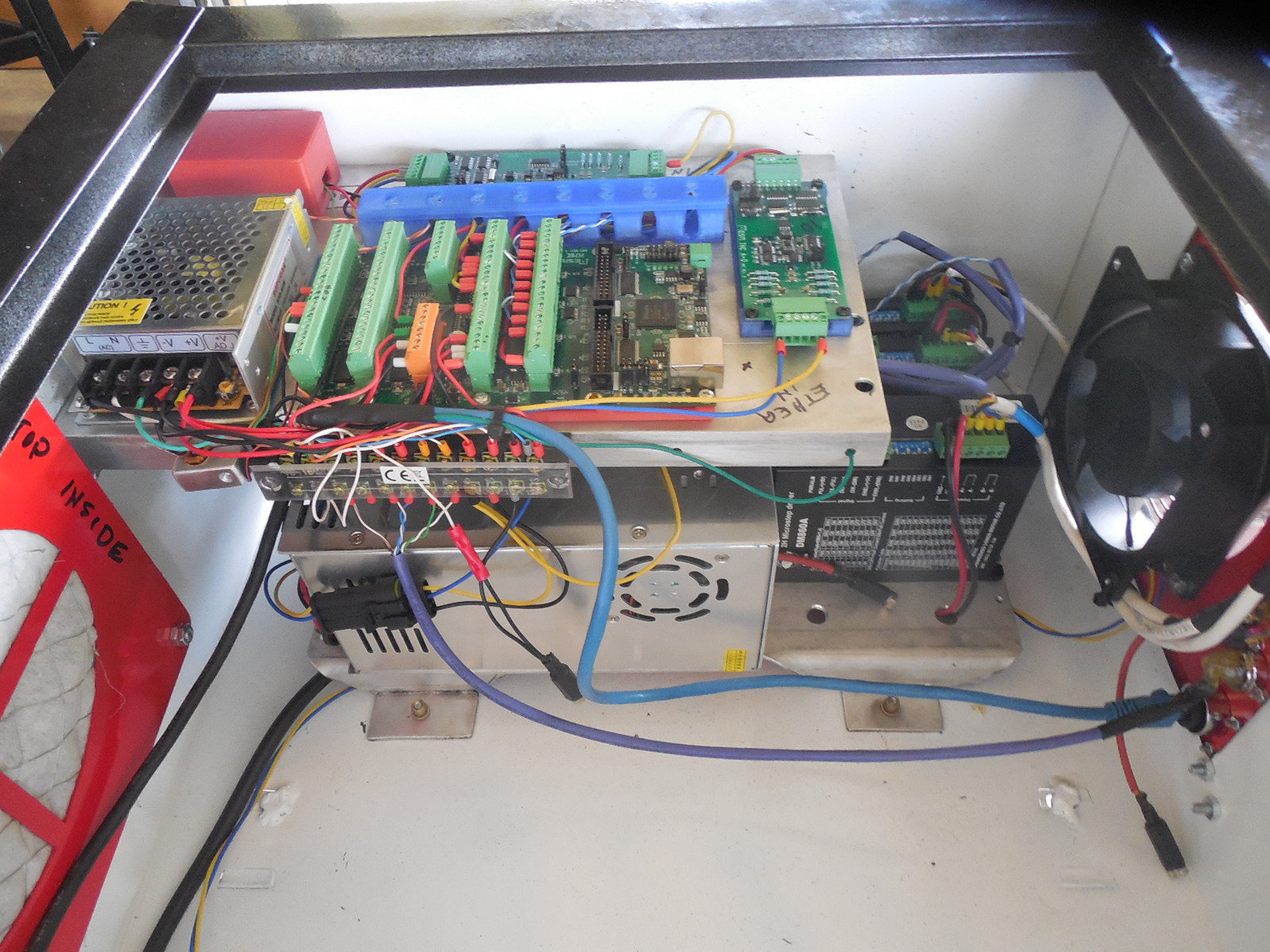New Project with Mesa 7I96 and THCAD-05
- acourtjester
- Offline
- Elite Member
-

- Posts: 292
- Thank you received: 29
Attachments:
Please Log in or Create an account to join the conversation.
- phillc54
-

- Offline
- Platinum Member
-

- Posts: 5711
- Thank you received: 2093
Please Log in or Create an account to join the conversation.
- rodw
-

- Offline
- Platinum Member
-

- Posts: 11565
- Thank you received: 3883
Please do not insert any components between the THCAD, the 24V DC power supply and the ohmic probe (like the relay shown). That is something PCW was very clear about.Sorry Tom, I forgot to post this yesterday. It needs a bit of work but should give you the general idea of what I did.
The THCAD circuit is deigned to be exposed to arc voltage and the use of appropriately rated components good for overvoltage of 500 volts (power supply and THCAD) makes this safe. Any relay there is likely to fail badly....
The whole intent was to remove any components from the torch side and provide a method of adjusting sensitivity.
Stick to the relay circuit or the published THCAD circuit. Do NOT mix and match!
Please Log in or Create an account to join the conversation.
- phillc54
-

- Offline
- Platinum Member
-

- Posts: 5711
- Thank you received: 2093
If you read the text you would see that I have no interest in the ohmic probe being active while not probing so I will isolate it if I choose to.Please do not insert any components between the THCAD, the 24V DC power supply and the ohmic probe (like the relay shown). That is something PCW was very clear about.
The THCAD circuit is deigned to be exposed to arc voltage and the use of appropriately rated components good for overvoltage of 500 volts (power supply and THCAD) makes this safe. Any relay there is likely to fail badly....
You would also see that the relay is rated plenty high enough for 500V as are the diodes.
There is basically no difference to the published circuit that John uses succesfully other than the relay and the THCAD.
Please Log in or Create an account to join the conversation.
- rodw
-

- Offline
- Platinum Member
-

- Posts: 11565
- Thank you received: 3883
Of course I understand you are not using a THCAD from what you wrote. Its fine for you to do what you want.
Please do not insert any components between the THCAD, the 24V DC power supply and the ohmic probe (like the relay shown). That is something PCW was very clear about.
The THCAD circuit is deigned to be exposed to arc voltage and the use of appropriately rated components good for overvoltage of 500 volts (power supply and THCAD) makes this safe. Any relay there is likely to fail badly....
If you read the text you would see that I have no interest in the ohmic probe being active while not probing so I will isolate it if I choose to.
You would also see that the relay is rated plenty high enough for 500V as are the diodes.
There is basically no difference to the published circuit that John uses succesfully other than the relay and the THCAD.
I was going to proceed the same way until I got this advice from PCW at Mesa:
We should not be publishing things that differ from Mesa's view.No relays or diode should be needed when using a THCAD for OHMIC sensing
(basically its impedance protected)
Please Log in or Create an account to join the conversation.
- phillc54
-

- Offline
- Platinum Member
-

- Posts: 5711
- Thank you received: 2093
No relays or diode should be needed when using a THCAD for OHMIC sensing
(basically its impedance protected)
I agree with that statement, however it does not say "relays or diodes should not be used".
Please Log in or Create an account to join the conversation.
- rodw
-

- Offline
- Platinum Member
-

- Posts: 11565
- Thank you received: 3883
No relays or diode should be needed when using a THCAD for OHMIC sensing
(basically its impedance protected)
I agree with that statement, however it does not say "relays or diodes should not be used".
No but this does
Respectfully, I spent several weeks working through this with Peter Wallace from Mesa. The intention is clear as conveyed in the circuit diagrams published.I would not isolate the input but rather just turn off the power supply when not
probing if you are concerned about electrolytic corrosion
Please Log in or Create an account to join the conversation.
- phillc54
-

- Offline
- Platinum Member
-

- Posts: 5711
- Thank you received: 2093
I don't read that as being mandatory either.No but this does
I would not isolate the input but rather just turn off the power supply when not
probing if you are concerned about electrolytic corrosion
I also don't understand what the problem is, I am not intending to use a THCAD for probing.
Please Log in or Create an account to join the conversation.
- snowgoer540
-

- Offline
- Moderator
-

- Posts: 2524
- Thank you received: 855
Not sure if I can get to the power supply at this point as it is below the shelf that has the 7I76E and THCADs.
Assuming the blue box'd power supply in the picture is the one you are using for OHMIC, then it looks like it is not an isolated power supply (it looks like it has a ground hooked up to it). Further, if it has a spot to hook a ground to it, then it definitely is not the double insulated isolation class II type power supply that is recommended. This is dangerous.
Respectfully, I spent several weeks working through this with Peter Wallace from Mesa. The intention is clear as conveyed in the circuit diagrams published.
I don't think anyone is trying to take away from the work Peter and you did. But from my experience (and that of a few others) with THCAD Ohmic in the last year+, there is room for improvement.
If the intention was to prevent electrolysis, then both Peter's circuit suggestion, and Phill's circuit would accomplish that.
One advantage of using the diodes, especially if they are well placed, is that it keeps the cutting voltage/current out of the cabinet. This can also prevent catching someone's wiring on fire...
It also prevents voltage accumulation in the THCAD circuit. I've seen this issue, and I know at least one other person has as well. Not really documented on the forum, but if you do enough cutting, and monitor the voltage of the THCAD circuit, you may see that the voltage in the circuit steadily creeps up over time. The other guy I am referring to does a lot of cutting of thin gauge material and it's to the point where he disabled the THCAD ohmic circuit entirely because the voltage would be hovering near the threshold and sometimes trips the sensor prior to, or during a probe (before contacting the material, and with a dry torch).
One advantage of the relay as shown in Phill's circuit is that it makes the voltage instantly zero, and instantly available. Whereas when hooked to the power supply it requires time for the capacitors to drain and fill.
Please Log in or Create an account to join the conversation.
- rodw
-

- Offline
- Platinum Member
-

- Posts: 11565
- Thank you received: 3883
If you add 2 diodes into the circuit, you would see a voltage drop of around 1.2 volts. (typically there is a 0.6v voltage drop across a diode). You would need to recalibrate the power supply and possibly the THCAD scaling resistor to account for this. You would also likely have to adjust the thresholds in the hal file.
The voltage should fall to instantly zero when the probe breaks contact. If it doesn't, then the only possible cause is some sort of short in the nozzle that allows voltage to flow where it shouldn't. If thats not resolved, probing is likely to be problematic.
If the voltage is too close to the threshold, you can change the threshold in hal. Ideally, you would allow adjustment of this from within your config if it was a major issue.
There is nothing in the circuit like a capacitor to store electrical potential so the only way I could see that voltage could slowly increase over time is if there was some kind of drift in the power supply (or a short in the torch).
Don't forget that Ohmic3 (not used in Toms Config here) was deigned to do the impossible and that was to allow ohmic sensing on a water table. Thats long been acknowledged as problematic and many industry sources recommend NOT using it on water tables. The effectiveness of Hypersensing is dependent on a lot of environmental factors some of which have been mentioned above.
I have long bypassed the optional mains relay as I found there were some issues in my setup including the long time discharging capacitors on power off.
Whilst mileage for others may vary, I have frequently done cutting jobs with over 1500 pierces on a water table with no probing issues. I feel the performance is improved over the earlier relay circuit I used.
My concern is that there are many circuit diagrams on the forum here and some of them of dubious quality have been used by many people with the mistaken belief that they are the gold standard. There are versions of the THCAD and relay circuits in the official Linuxcnc documents, its best we defer to them.
In terms of design, Ohmic sensing does not require a probe-enable signal because the additional isolation is not required. But to remain compatible with Plasmac, it does accept this signal and will not turn on a probe signal unless its present. A much cleaner design could be achieved if the probe-enable was removed from the ohmic component.
The THCAD circuit is probably more costly than the relay circuit but it requires fewer components and arguably more reliable. If correctly implemented, there is no risk of fires in the wiring. Properly configured it performs flawlessly where other systems don't. I can understand Phill added a relay when testing it becasue he had the relay in his control box. In a new build, the temptation to add these components should be ignored, this is just adding more expense with unnecessary components which do nothing other than to reduce MTBF.
Please Log in or Create an account to join the conversation.


